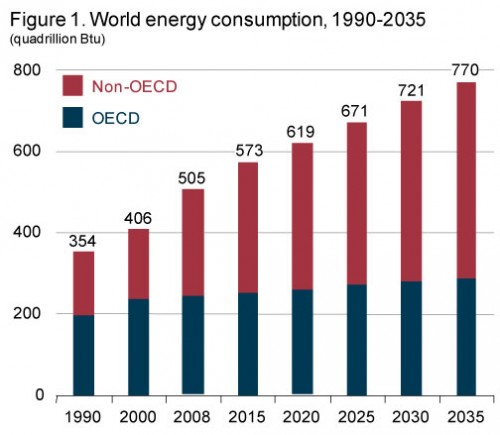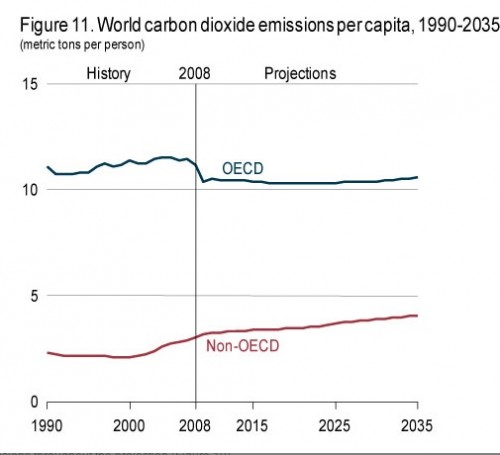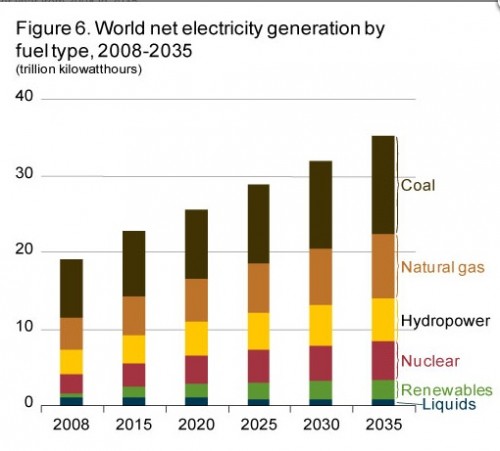The U.S. Energy Information Administration (EIA) just released a new report on projected growth in global energy consumption. In case you were wondering, it’s going to continue to climb, by an estimated 53% by 2035. And the majority of that energy use will occur in countries outside the highly industrialized nations that are members of the Organisation for Economic Co-operation and Development (OECD; map of member states):
That said, while non-OECD countries will consume the majority of energy, the OECD nations will continue to lead the world in carbon emissions per person, still more than twice that of non-OECD nations by 2035, according to projections:
While renewable energy sources will increase as a proportion of all electricity production, fossil fuels, especially coal and natural gas, will continue to be the most important sources:
If you are fascinated by the ins and outs of global energy use — how much different nations use, what different types of energy source are used for (electricity, transportation, etc.), and how carbon intensive different economies are — check out the full report, as it’s chock full of data. There are also customizable tables that allow you to select topics of interest and see trends in different nations over time. But I warn you: if, say, global climate change worries you, this isn’t exactly a soothing read.
(Via Talking Points Memo.)




Comments 9
Yrro Simyarin — September 21, 2011
I've said it a million times - until someone invents a way to make clean energy cheap enough that China will use it instead of coal, the first world CO2 regulations will barely matter.
Unfortunately, the research for that is unlikely to happen until coal gets a lot more expensive, which isn't going to happen naturally any time soon. But it's going to put a serious cramp in our entire economic system to make it expensive unnaturally, so no politician wants to touch that reality. Or, at least, not while admitting that that is the real goal, and the real side effects thereof. The first world is built on cheap energy. Making energy more expensive is not going to be good for its own poor.
abitha — September 21, 2011
Perhaps it would be worth pointing out that OECD countries only make up about 18% of the world's population (source: wikipedia article on OECD and wikipedia article on world population). Looking at the graphs without knowing that, it would be easy to assume that the OECD and non-OECD populations were approximately equal, and that the non-OECD countries were going to be using more than their share of power by 2035. (Incidentally, note that the second graph is 'per capita' rather than total CO2 emissions - which presumably takes account of predicted changes in global population, as well.)
Although Yrro does have a point about first-world CO2 regulations not being the complete answer (there is a graph in the full EIA report that illustrates the point about China's coal use splendidly), I would argue that they do have some place. Look at the first graph - as of 2008, OECD countries (18% of global population) consume approximately 50% of global energy. Capping the emissions related to that 50% is surely better than nothing, isn't it?
Global Energy Use Predictions through 2035 | Leaders Vision — September 23, 2011
[...] more: thesocietypages.org Bookmark on Delicious Digg this post Recommend on Facebook Buzz it up Share on Linkedin Share on [...]
How Not to Describe the Poverty Number and More Information « Welcome to the Doctor's Office — September 24, 2011
[...] GLOBAL ENERGY USE PREDICTIONS THROUGH 2035 by Gwen Sharp, [...]
Global Energy Use Predictions through 2035 | Environmental, Health and Safety News — September 25, 2011
[...] (View original at http://thesocietypages.org/socimages) [...]
cheap bras — January 29, 2012
Amazing write-up! This could aid plenty of people find out more about this particular issue. Are you keen to integrate video clips coupled with these? It would absolutely help out. Your conclusion was spot on and thanks to you; I probably won’t have to describe everything to my pals. I can simply direct them here!
Anonymous — February 5, 2024
thanmks
ousmane — June 16, 2025
Transformed my home office into a remote-work space last winter, and ensuring reliable power became a top concern—especially during storm season. As landscaping crews trimmed branches nearby, I decided to prepare a backup plan in case of outages. In the midst of checking resources, I reviewed Xcel Energy phone number to learn how responsive their customer service is during power interruptions. Some residents reported fast, helpful updates and quick restoration times, while others experienced long holds or limited crew availability in rural areas. That range of feedback prompted me to note down that contact method and sign up for outage alerts. Since then, we’ve had a couple of brief outages and the support info made it all feel less stressful—and outages were resolved faster than expected.